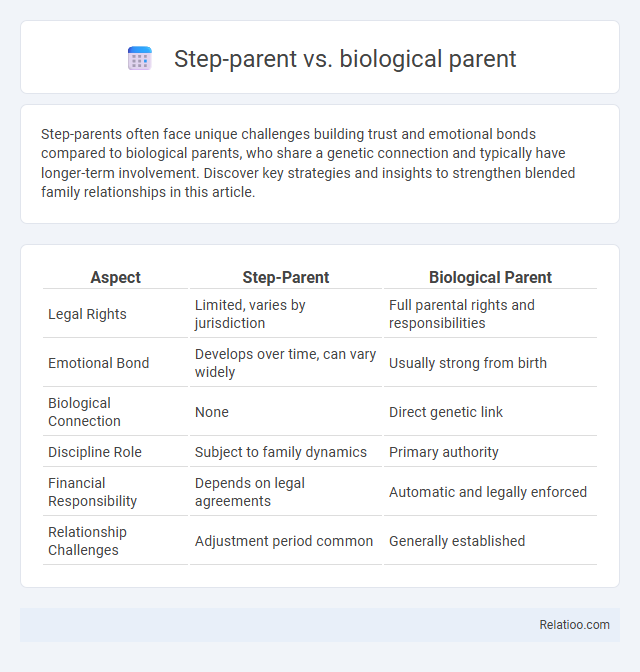Step-parents often face unique challenges building trust and emotional bonds compared to biological parents, who share a genetic connection and typically have longer-term involvement. Discover key strategies and insights to strengthen blended family relationships in this article.
Table of Comparison
| Aspect | Step-Parent | Biological Parent |
|---|---|---|
| Legal Rights | Limited, varies by jurisdiction | Full parental rights and responsibilities |
| Emotional Bond | Develops over time, can vary widely | Usually strong from birth |
| Biological Connection | None | Direct genetic link |
| Discipline Role | Subject to family dynamics | Primary authority |
| Financial Responsibility | Depends on legal agreements | Automatic and legally enforced |
| Relationship Challenges | Adjustment period common | Generally established |
Understanding the Roles: Step-Parent vs Biological Parent
Understanding the roles of step-parents versus biological parents is essential for fostering family cohesion, as step-parents often navigate unique challenges in establishing authority and emotional bonds within a blended family. Biological parents typically hold inherent rights and a lifelong connection that influence family dynamics, while step-parents support family stability through cooperation and respect for existing relationships. Clear communication and mutual respect between all parties enhance trust and promote a cohesive family environment.
Legal Rights and Responsibilities
Legal rights and responsibilities differ significantly between step-parents and biological parents, influencing family cohesion and stability. Biological parents typically have automatic legal rights regarding custody, visitation, and decision-making, while step-parents must often obtain legal adoption or guardianship to gain similar authority. Family cohesion strengthens when legal frameworks clearly define roles and protect the interests of all parties involved, minimizing conflict and fostering cooperation within blended families.
Emotional Bonding and Attachment
Emotional bonding and attachment differ significantly between step-parents and biological parents, impacting family cohesion. Biological parents often share stronger genetic ties that facilitate innate emotional connections, while step-parents must build trust and attachment over time through consistent support and involvement. Successful family cohesion depends on the quality of these emotional bonds, where secure attachment in step-families enhances relational stability and overall family functioning.
Parenting Styles and Approaches
Parenting styles significantly shape family cohesion, with biological parents often exhibiting established patterns based on shared history, while step-parents may adopt adaptive approaches to build trust and alliance within blended families. Research highlights authoritative parenting--characterized by warmth and structure--as the most effective in promoting positive family dynamics and child adjustment across both step-parent and biological parent roles. Your ability to foster open communication and consistent expectations enhances cohesion, regardless of genetic ties, by creating a supportive and stable environment for the entire family.
Navigating Discipline and Authority
Navigating discipline and authority in families with step-parents involves balancing respect for the biological parent's established role while fostering mutual trust and clear boundaries. Step-parents should communicate openly with biological parents to ensure consistent rules and disciplinary strategies that support family cohesion. Research underscores that cooperative co-parenting enhances children's adjustment and reduces conflicts, promoting a stable and harmonious household.
Conflict Resolution in Blended Families
Conflict resolution in blended families requires tailored approaches that respect the unique dynamics between step-parents and biological parents, fostering family cohesion. Understanding your role as a step-parent involves balancing authority with empathy to mediate disputes and build trust among family members. Effective communication strategies and consistent conflict management techniques enhance emotional bonds, ultimately strengthening the blended family's unity and resilience.
Impact on Child Development
The impact of step-parents versus biological parents on child development varies significantly, with biological parents often providing more consistent emotional security and attachment, which are crucial for healthy growth. Your child's adjustment and psychological well-being can benefit from strong family cohesion, regardless of family structure, when open communication and supportive relationships are prioritized. Research shows that positive interactions in stepfamilies can enhance resilience and social skills, highlighting the importance of nurturing family bonds for optimal child development.
Challenges and Opportunities for Step-Parents
Step-parents often face unique challenges such as building trust and navigating loyalty conflicts within blended families, which can impact overall family cohesion. Opportunities for step-parents include fostering strong relationships by actively supporting the child's emotional needs and collaborating with biological parents to create a stable, unified family environment. Effective communication and consistent involvement in family routines enhance step-parents' roles, ultimately promoting greater family cohesion and child well-being.
Supporting Healthy Family Dynamics
Supporting healthy family dynamics involves recognizing the unique roles of step-parents and biological parents in fostering family cohesion, as each contributes differently to emotional support and stability. Your efforts to build trust, open communication, and respect among all family members strengthen bonds and create a nurturing environment. Prioritizing these elements helps ensure lasting connections and resilience in blended and traditional family structures.
Tips for Successful Co-Parenting
Successful co-parenting between step-parents and biological parents requires clear communication, mutual respect, and consistent boundaries to strengthen family cohesion. Prioritize open dialogue about parenting styles and shared goals to create a unified approach that supports Your child's emotional well-being. Building trust through collaboration and empathy fosters a positive environment where both parental roles complement each other effectively.

Infographic: Step-parent vs Biological parent
 relatioo.com
relatioo.com